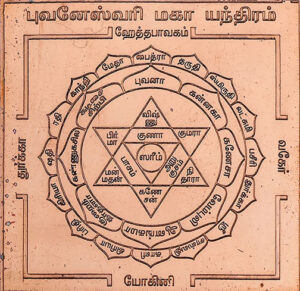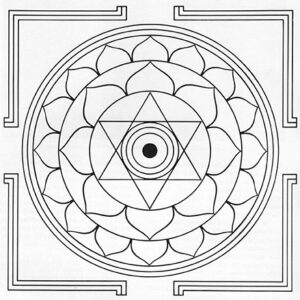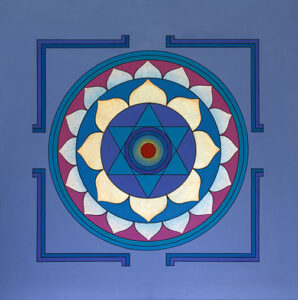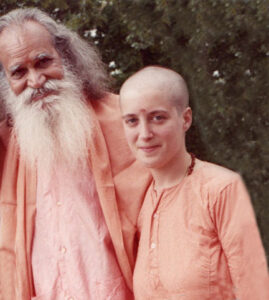
Depiction of Goddess Bhuvaneshvari Embodied Within Her Yantra.
In the sacred stillness of the Palani Hills, at the samadhi shrine of the great Siddhar Bhogar, a seed of profound transformation was sown in the heart of a young seeker named Ramasamy. Years later, known to the world as Sri Swami Satchidananda, he would carry that seed across continents and into the lives of thousands, expressing its essence through one of the most subtle and powerful tools of the Shaiva-Shakta Tantric Yoga tradition: a yantra.
What Is a Yantra?
A yantra is more than just a geometric diagram—it is the visual crystallization of divine sound, the form of mantra made visible. In the Tantric tradition, mantra (sound) and yantra (form) are considered inseparable, much like Shiva and Shakti, word and meaning, essence and expression. As the ancient grammarian Bhartrihari declared, “The Brahman, the Absolute, is of the character of speech (shabda) as it is.” This speech—this resonance—unfolds into form, becoming yantra, a tangible expression of the ineffable.
A mantra is the sonic body of the deity; the yantra is the visual body. Mantra activates; yantra stabilizes. When engaged in meditation or ritual, the practitioner channels energy through the mantra and gives it a sacred seat through the yantra. Each yantra consists of foundational elements—square, circle, triangle, and bindu (point)—symbolizing the various stages and aspects of cosmic manifestation and spiritual transmission.
Practitioners often install yantras in meditation rooms or sacred spaces, where their vibrational influence subtly permeates the environment. Used as visual focal points, yantras draw the gaze and the mind inward—from outer forms to inner stillness. A common method of practice is to gaze into the central bindu while silently repeating the associated bīja mantra. Over time, this harmonizes thought, breath, and awareness, and the yantra becomes not only a map of the cosmos but also a mirror of the True Self.
Even for those unfamiliar with their deeper symbolism, yantras emanate a sacred presence. As Swami Satchidananda emphasized, these are not mere decorations but powerful instruments of divine connection—silent partners in spiritual unfolding.
Bhogar and the Legacy of Bhuvaneshvari
In prior parts of this series, we explored the remarkable life of Siddhar Bhogar, a Tantric alchemist, yogi, and visionary who worshipped the Divine Mother in her form as Bhuvaneshvari—the Queen of the Universe. Bhogar’s approach to realization was deeply aesthetic, inwardly alchemical, and outwardly devotional. He worshipped the Maragatha (emerald) Shiva-Shakti Lingam flanked by the yantra of Goddess Bhuvaneshvari. Through visualization, mantra repetition, and meditation upon Her form and yantra, he merged with the Shakti that both conceals and reveals the Absolute.

Bhuvaneshvari Maha Yantram: “Great Yantra of Bhuvaneshvari” (Tamil translation) on copper.
Unlike some ascetic lineages that emphasized rigorous austerity and the burning away of desire, Bhogar’s was a path of love, beauty, and transcendence through harmony. His devotion to Bhuvaneshvari emphasized Her maternal, expansive, and protective nature—a perfect mirror to the inner experience and devotion of Ramasamy in his own spiritual life.
Ramaswamy’s Inner Experience at Palani
While sitting in meditation at Bhogar’s shrine, Ramaswamy experienced a profound inner connection with the spiritual current of that sacred site. This wasn’t a historical interest, but a transmission—a living inspiration. The Divine Mother, as Bhuvaneshvari, awakened in him not only the remembrance of lifetimes of practice but also a vision for how Her Grace could be shared with seekers far from Tamil Nadu and far from traditional Hindu forms.
He later described how everything he would eventually teach was seeded during that period. And when it came time to formalize the spiritual symbols that would carry Integral Yoga into the future, it was this early communion with Bhogar and Bhuvaneshvari that emerged from his heart.
A Deliberate Choice: Bhuvaneshvari Yantra, Not Sri Yantra
As was described in part 11 of this series, Swami Satchidananda always wore a medallion close to his heart, etched on one side with an image of the Supreme Goddess Raja Rajeshvari and on the other, the Śrī Yantra. The Śrī Yantra—an intricate labyrinth of nine interlocking triangles—has long been revered in the Śrī Vidyā tradition as the supreme cosmic diagram, a pathway through creation to the Absolute. It was the yantra of his personal devotion.
The Śrī Yantra, while extraordinarily powerful, demands a high degree of subtle concentration, ritual precision, and often Guru-guided initiation. For many Western students, new to Eastern philosophy and unfamiliar with ritual intricacies, its complexity might have overwhelmed rather than uplifted. Swami Satchidananda, always attentive to the heart and readiness of his students, chose a yantra that was approachable yet no less transformative, as he also did with his choice of bīja mantra.
In Part 15, we noted:
“Swami Satchidananda’s embrace of Bhuvaneshvari’s bīja was not merely doctrinal—it was deeply personal. In his many writings and talks, he often spoke of the need to live from the heart, to cultivate expansive awareness and equanimity. The path of Integral Yoga was designed not to shock the system into awakening, but to gently reveal one’s inherent peace.”
The Bhuvaneshvari Yantra—the sacred geometrical form of the Goddess’s bīja—with its concentric circles, petals, and six-pointed star, invites the practitioner less dramatically into a conquest over the ego and more gently into the unfolding of the heart. In this way, he honored the tradition without burdening it with formality. What mattered was not complexity, but connection. Not power, but purity of heart.
The Integral Yoga Yantra: A Transmission of the Mother

Photo of black & white drawing of the yantra.
To express this vision tangibly, Swami Satchidananda gave his first students a black and white drawing of a yantra. Then, in the early 1980s, he asked Tim Barrall, a devotee and artist in the Integral Yoga community, to paint a full-color yantra—a modern rendering of the traditional Bhuvaneshvari Yantra. This sacred image became the original Integral Yoga Yantra and not merely as artwork or decoration. It was a mystical diagram carrying both lineage and intention, infused with the vibrations of its source and creator.
Swami Satchidananda offered this powerful description:
Integral Yoga is a complete Yoga system and the Integral Yoga Yantra is also complete. It is a representation of the entire cosmos. Each part of the yantra corresponds to a different aspect of the cosmos. According to yogic thinking, God or the Cosmic Consciousness, is originally unmanifest. The first expression is as the sound vibration. The Bible explains it by saying, “In the beginning was the Word, and the Word was with God, and the Word was God.” Here “word” means sound.
In Sanskrit they say something similar but take it a step further: “Nada, bindu, kala”—the sound, then the dot, then the art or rays. If God manifests as sound, you can’t see anything. What is the smallest expression which you could see? The bindu or dot. It should be the smallest possible particle. But, of course, if it is that small we can’t see it, so in the yantra it is shown as a large dot in the very center. The bindu represents the first physical expression, the very core of the cosmos. It is that dot which then expresses as kala. Kala means the different aspects or literally the different rays or different arts.
The next expressions are the three rings of different hues surrounding the bindu. They represent the three gunas or basic qualities of nature: sattva (balance), rajas (activity) and tamas (inertia). In the yogic thinking, everything in this universe manifests uniquely because it results from a unique combination of these three. All differences in the phenomenal world are due to the variations of these three basic qualities.
Then you see the hexagon around the three rings. This can be very well explained with an example from science. If you take a photograph of a crystal, you will see that its normal shape is six-sided. That’s why the yantra has the six triangles around the center. It means that the first speck of matter expresses itself as more complex matter like a crystal.
The six triangles are actually a combination of two larger triangles, one pointed down, the other up. As one triangle passes through the other, we get this six-sided figure. The triangle with apex upward represents the masculine aspect; the inverted triangle is the feminine, aspect. In Sanskrit this concept is called Shiva-Shakti, equally represented and blended perfectly together. Whichever way you turn the yantra, they remain the same. So, it makes a complete whole, and this itself represents the entire nirguna (unmanifest) as well as saguna (manifest) aspects of the Supreme.

Photo of original Integral Yoga Yantra in color.
Once the triangles come together, the hexagon could then represent something else also: the six basic tattvas or principles—the five senses and the mind as the sixth. The six-sided crystal then manifests outward in further expansions of the primordial energy and matter. Why and how does this happen? Out of love. So, all the beautiful lotus petals represent the loving manifestation. Another way of explaining the petals is that the eight inner petals represent the subtle elements, while the sixteen outer ones indicate their grosser manifestations.
Then you see the three large circles surrounding the lotuses. They indicate how these elements further express as the three worlds: causal, astral and physical. But even that is not the end. The Divine expression is unlimited. That is why the circles are framed by a square with gaps pointing outward, representing the infinity of creation.
A Yantra for the Heart
In many classical Tantric traditions, spiritual energy is harnessed through fierce intensity, deep esotericism, and advanced practices. But Swami Satchidananda, following the example of Bhogar, offered a different way: the gentle way of the Mother.
By choosing Bhuvaneshvari’s bīja and yantra as the heart of Integral Yoga, he gave students a key not to domination of mind or control of energy—but to inner flowering. To balance. To the space of vast inclusion. Just as her name means “She Who Encompasses the Worlds,” her symbol calls us into wholeness.
In meditating on this yantra, one does not conquer, but yields. One does not strive but opens. In the presence of this sacred form, one is invited into the presence of the Divine Mother. Let your eyes rest on its soft geometry. Feel its quiet pulse. Allow it to awaken something within—that which knows your essential nature. In a world so often fragmented, the yantra offers a glimpse of what cannot be broken—Divine wholeness radiating from the center of your being.
In the next part of this series, we’ll explore how Swami Satchidananda expanded the Integral Yoga Yantra to reflect a universal vision—adding symbols of the world’s faiths and a three-dimensional yantra in the form of the Light Of Truth Universal Shrine (LOTUS).
[ Original Yantra + All Faiths Yantra Now Available in our Integral Yoga Shop ]
About the Author:
 Swami Premananda, Ph.D. is a senior disciple of Sri Gurudev Swami Satchidananda and served as his personal and traveling assistant for 24 years. Her interest in the study of the spiritual roots of the Integral Yoga tradition and lineage was inspired over many years of traveling with Sri Gurudev to the various sacred sites throughout India that are a part of this tradition. She also undertook a 2-year immersion into the nondual Saiva Yoga Siddhar tradition that is at the heart of Sri Gurudev’s spiritual roots. She further studied the history, sacred texts, and teachings of Advaita Vedanta and Tamil Saivism including the Siddhars, bhakti poet saints, as well as the spiritual luminaries who lived in the 19th – 20th centuries and who inspired Sri Gurudev, such as Sri Ramana Maharshi, Swami Ramdas, and Swami Vivekananda. She serves as editor of Integral Yoga Magazine, Integral Yoga Publications; senior archivist for Integral Yoga Archives; and director of the Office of Sri Gurudev and His Legacy.
Swami Premananda, Ph.D. is a senior disciple of Sri Gurudev Swami Satchidananda and served as his personal and traveling assistant for 24 years. Her interest in the study of the spiritual roots of the Integral Yoga tradition and lineage was inspired over many years of traveling with Sri Gurudev to the various sacred sites throughout India that are a part of this tradition. She also undertook a 2-year immersion into the nondual Saiva Yoga Siddhar tradition that is at the heart of Sri Gurudev’s spiritual roots. She further studied the history, sacred texts, and teachings of Advaita Vedanta and Tamil Saivism including the Siddhars, bhakti poet saints, as well as the spiritual luminaries who lived in the 19th – 20th centuries and who inspired Sri Gurudev, such as Sri Ramana Maharshi, Swami Ramdas, and Swami Vivekananda. She serves as editor of Integral Yoga Magazine, Integral Yoga Publications; senior archivist for Integral Yoga Archives; and director of the Office of Sri Gurudev and His Legacy.

